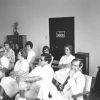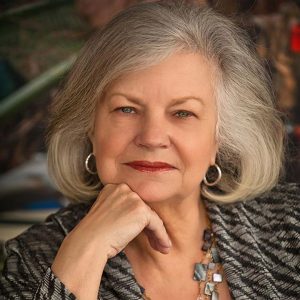calsfoundation@cals.org
Ruth Hawkins (1947–)
Ruth Hawkins has made a lasting impact on the preservation of Arkansas heritage and culture throughout the state as an advocate for historic preservation. She also oversaw the development of numerous preservation projects around the state, including the Johnny Cash Boyhood Home.
Ruth Anne Wehmer was born in St. Louis County, Missouri, on March 31, 1947, and grew up on a farm located near the confluence of the Mississippi and Missouri Rivers with her parents, Hazel Snoddy Wehmer and James Henry Wehmer, and eleven siblings. She developed an understanding of the hardships that come with farm life, where a family’s livelihood could change with the weather. Hawkins attended Christian (now Columbia) College in Columbia, Missouri, for two years, where she discovered her passion for journalism, and received a BA in 1967. She later received her Bachelor of Journalism degree from the University of Missouri School of Journalism in 1969, where she met her future husband, Van Hawkins, who was also a student there. They married and had a son.
After graduation, Hawkins moved to Norfolk, Virginia, when her husband, who was in the U.S. Navy, was relocated for the Vietnam War. During this time, Hawkins worked in Virginia as a television and newspaper reporter. She also worked as a public school information officer. In 1978, Hawkins and her husband moved to Paragould (Greene County) to be closer to his family and to help on the family farm. During this time, she took a job as head of the Advancement Division at Arkansas State University (ASU) in Jonesboro (Craighead County). She received an MA in political science in 1982 from ASU and received a doctorate in higher education administration from the University of Mississippi in 1988.
Hawkins began working in the sector of historic preservation and created her own title as the director of the ASU Heritage Sites Program, becoming a force behind some of the largest preservation projects in Arkansas; she also served as the executive director of Arkansas Delta Byways. In 1998, the Crowley’s Ridge National Scenic Byway, a 198-mile route that ran through the countryside between Helena-West Helena (Phillips County) and Piggott (Clay County), was officially designated. The anchor point of the byway was the homestead of Paul Pfeiffer, whose daughter, Pauline Pfeiffer, had married Ernest Hemingway, and which Hawkins and her team transformed into the Hemingway-Pfeiffer Museum. The impact of this historical museum on the local community was almost immediate, with fourteen new businesses opening in Piggott within the first two years of the museum being there. By 2025, the Arkansas State University Heritage Sites program oversaw the policies and programs for the Southern Tenant Farmers Museum in Tyronza (Poinsett County), the Lakeport Plantation in Lake Village (Chicot County), the Hemingway-Pfeiffer Museum and Education Center in Piggott, and the Historic Dyess Colony: Johnny Cash Boyhood Home in Dyess (Mississippi County).
Hawkins has published two books. The first, Unbelievable Happiness and Final Sorrow: The Hemingway-Pfeiffer Marriage, was published by the University of Arkansas Press in 2012. (She had, in 1999, guest-edited an issue of the Arkansas Review: A Journal of Delta Studies on Hemingway’s Arkansas connections and contributed the essay “Pauline Pfeiffer: Hemingway’s Behind-the-Scenes Editor.”) A second book, titled Journeys toward Home: Essays on Ancestors and Their Paths to Missouri, was published by Writers Bloc in 2025.
Hawkins received a lifetime achievement award from the Historic Preservation Alliance of Arkansas (now Preserve Arkansas); earned a lifetime achievement award from the Arkansas Museums Association; was inducted into the Arkansas Tourism Hall of Fame; and received an Arkansas Historical Association Diamond Award for her efforts to restore, preserve, and promote Arkansas heritage sites properties. She was a 2017 inductee to the Arkansas Women’s Hall of Fame and has been recognized for being awarded almost $30 million in grants for the preservation and conservation of historical and heritage sites in the Arkansas Delta region.
For additional information:
Blatti, Jo. “Interview with Ruth Hawkins.” First Person Plural: An Oral History of Arkansas Women. David and Barbara Pryor Center for Arkansas Oral and Visual History, University of Arkansas, Fayetteville. https://pryorcenter.uark.edu/project.php?thisProject=21 (accessed July 29, 2025).
Massey, Kyle. “Dr. Ruth Hawkins: Honoring History and Heritage.” Arkansas Business, August 14–20, 2017, pp. 18–19. Online at https://www.arkansasbusiness.com/article/arkansas-womens-hall-of-fame-dr-ruth-hawkins-honoring-history-and-heritage/ (accessed July 29, 2025).
“Morrison, David. “Ruth Hawkins, ’67 Earns Place in Arkansas Women’s Hall of Fame.” CC Connected, July 31, 2017. https://connected.ccis.edu/2017/07/ruth-hawkins-67-earns-place-in-arkansas-womens-hall-of-fame/ (accessed July 29, 2025).
Rice, Joe David. “Ruth Hawkins: The Delta Rainmaker.” Arkansas Money and Politics, July 2018. https://www.armoneyandpolitics.com/ruth-hawkins-the-delta-rainmaker/ (accessed July 29, 2025).
Mikaela Bailey
University of Arkansas at Little Rock Center for Arkansas History and Culture
 Divergent Prosperity and the Arc of Reform, 1968–2022
Divergent Prosperity and the Arc of Reform, 1968–2022 Ruth Hawkins
Ruth Hawkins  Ruth Hawkins
Ruth Hawkins  Lakeport Plantation Meeting
Lakeport Plantation Meeting 



Comments
No comments on this entry yet.